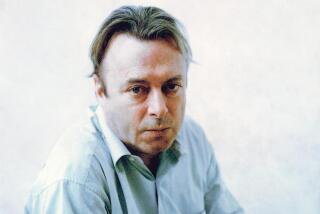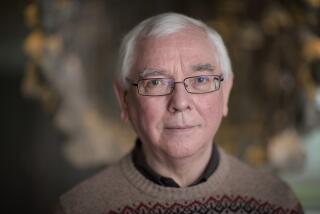The Best of Writers : DICKENS: Life and Times. <i> By Peter Ackroyd</i> . <i> (HarperCollins: $35; 1,195 pp.)</i>
His feckless parents struggled to cling to the middle class, and as a boy Charles Dickens helped pawn their books and furniture while the large family moved from house to house, from Kent to Camden Town to London, and from respectability to the Marshalsea debtors’ prison, where in 1824 for three months all but one of them lived.
Charles Dickens, barely 13, was locked out. He worked in a shoe-blacking factory among rough boys and lived on his own in a small room. He roamed a dark, sinister London alone, and he later wrote of those days: “It is wonderful to me how I could have been so easily cast away at such an age.” Wherever his holidays, romances, research trips or celebrated public readings were to take him, he would return in memory and metaphor to a terrifying city and a small child crushed by menace, abandonment and helplessness.
In “Oliver Twist” or “A Tale of Two Cities,” in “David Copperfield” or “Little Dorrit,” he wrote of the nightmare world of children. No matter his considerable wealth and vast fame, he fretted about money and always complained of “a vague unhappy loss or want of something” that he couldn’t name or fulfill. His angers were both selfish and generous, and they focused his art not only on his own childhood fears but on the immense wrongs of his day.
The age in part created Charles Dickens, and he in part created his age. The man in his time is what Peter Ackroyd so capably shows us in this huge new biography. Here we have the young journalist who wrote by guttering candles in cramped rooms. We see Dickens as he rises from debt and insecurity in a time when children crawled through reeking sewers to scavenge bits of glass and bone while “resurrection-men” dug up graves and sold the dead. Thames water was drawn for the poor to drink; it received the open streams of sewage that the poor had filled. In 1839, when Dickens was 27 and moving his family to a solid middle-class home--he was already the famous author of “Oliver Twist”--half of the funerals in London were for children under 10.
Dickens wrote about those children. He was the most celebrated writer of his time because he showed his age to itself. He also transformed the ordinary particulars of his time with a theatrical, fabulous vision that showed the early and middle Victorians what went on beneath the surfaces he both celebrated and excoriated. His books bear those times to us today. His characters--Pip, David, Nell, Gradgrind, Murdstone, Quilp--remain great for us. So does the story of their author, who wrote because his life depended on giving birth through his remarkable will and talent to himself. Ackroyd tells us this story with grace and power, often with brilliance.
The first great contemporary biography of Dickens was the two-volume “Charles Dickens: His Tragedy and Triumph” by Edgar Johnson, published in 1952. It set the standard for impeccable scholarship (and admiration of its subject). Its 1,141 pages of text and copious end notes are joined by the 556 pages of text and 29 pages of end notes in the 1988 “Dickens: A Biography” by Fred Kaplan. Between the hugeness of the Johnson and the concision of the Kaplan, with its meticulous prowling through the bounties of new Dickens material unearthed over a quarter of a century, readers and students had what they needed: faithful attention, and a new fearless discussion of Dickens’ marriage and its breakdown--he discarded his wife, who had borne 10 children--and his lifelong attention to handsome young women, his sad, long affair with a sometime actress, Ellen Ternan. We learned what we needed about his career as aspiring actor, journalist, editor, writer of fiction, son of irresponsible parents; his stern fatherhood, his dominance over his day.
But we have never had such extended and witty attention to how the great writing was done--and such attention ought to be at the heart of a writer’s biography. That is where Richard Ellmann’s lives of Yeats and Joyce display their magnificent achievement and where Johnson, Kaplan and such early predecessors as Dickens’ friend and agent, John Forster, do not succeed. That is where Ackroyd, a distinguished novelist and biographer, makes his major contribution. He not only comes as close as may be possible to suggesting what it was like to live in Dickens’ London--Dickens surely is the great writer of urban life--but he writes movingly of the process of Dickens’ creating, and there are times when we may feel that we actually see how the magic was achieved.
Ackroyd shows us Dickens as he probably was--the man who walked compulsively, sometimes for 20 or 30 miles at a clip. He shows us Dickens buying the very house his father had once suggested to the boy as an example of what a successful man might one day achieve. He shows us the man enslaved to writing, to editing--All the Year Round, his final weekly magazine, had a circulation of 300,000--and to giving public readings so often, so frenziedly, that they killed him. Ackroyd shows us how this moody and disappointed man, while in the deepest sorrows, wrote his funniest humor. Ackroyd shows us the writer who not only beat the system, but who became the system.
Ackroyd understands Dickens, and he understands how writing works. He shows us how Dickens seized at the myths that the literary and semiliterate found at the heart of fairy tales and fables, and he shows us how Dickens made his personal demons about abandonment and loss of control into stories essential to everyone. Ackroyd, a Londoner, loves and understands cities in general and London in particular. He is able to speak fascinatingly about Dickens’ dark evocations of urban life. Hear Dickens, in “A Christmas Carol,” describing how “candles were flaring in the windows of the neighboring offices, like ruddy smears upon the palpable brown air.” Ackroyd makes us see Charles Dickens in that smoky time and place.
To his good telling of a magnificent story, Ackroyd brings the style of his novels (“The Great London Fire,” “Chatterton,” “First Light”), and the match of matter and manner is often fine. Here Ackroyd evokes the 19th-Century rural populace that “poured into the narrow streets; poured into the jerry-built houses constructed back to back without drainage; poured into the cellars; poured into the frowsy lanes which had a channel of sewage running along them; poured into the cellars; poured into the once-grand buildings which had become a jangling honeycomb of tenements. . . .”
Ackroyd echoes Dickens’ prose (the master often chose to use extended series of phrases beginning with verbs), and he’s often successful in doing so.
Where Ackroyd’s prose fails Dickens and maybe many readers is in an automatic use of unessential sentence fragments. Describing Dickens’ fascinated, horrified reaction to a public hanging, Ackroyd writes that “the feeling of horror is genuine and private.” He can now leave the moment alone, secure that it’s effectively described, or go on to analyze Dickens’ response. He chooses to write too much that adds too little, and he resorts to bathetic prose: “Private anxiety fueling public denunciation. The horror of life. The pity of life.”
As enthusiastic about his subject as he should be, Ackroyd is given at times to sententiousness. So Dickens came “crying into the world,” we’re told on Page 1. The need to announce, along with a need to reinforce with comment what has just been clearly shown, results in tones more appropriate to Dickens’ funnier re-creations of his father’s pomposities: “So far had the young author already come”; “So did the real world enter Dickens’ fiction”; “So did his life, interior and exterior, continue.” Where was Ackroyd’s editor?
And this final complaint: There are neither footnotes nor end notes in this book. Perhaps some readers will be grateful. Despite Ackroyd’s small essays about some of the sources he consulted, found in an appendix, the interested reader cannot follow Ackroyd directly to his reading. The book will be deemed untrustworthy by many, and it’s hard to understand why Ackroyd chose to be both unhelpful and unreliable. The story he tells us is of course unaffected--unless you want to know how he knows what he says he knows, and how you can find out more.
But we must be grateful for what Ackroyd does so well. He suggests the problems inherent in turning the life of a century, and the life of a man, into a story that readers want to hear. And he lets us feel what the art of writing might be like: “It was not an instant or an easy process, and throughout Dickens’ writing life, the symptoms at the beginning of a new novel are the same. ‘Violent restlessness, and vague ideas of going I don’t know where. . . .’ And then again, ‘ . . . it is like being driven away. ‘ “
Ackroyd describes how “Dickens became irritable, solitary, preoccupied, ‘ . . . going round and round the idea . . .’ not being able to settle on any one thing and therefore not able to rest.” And Ackroyd makes him see how for Dickens “the characters come and settle within the narrative, bringing with them their own lines of force which complicate the essential plot.”
Ackroyd can tell us what a novelist knows by heart: Storytelling is “part of the process of consciousness rather than some neatly defined and independent activity . . . a way of creating a pattern out of these random and fortuitous items which somehow lodged in Dickens’ consciousness.” Ackroyd understands creative accidents, the uncontrolled consciousness, facts of London life and of Dickens’ history: He sees , quite wonderfully, and so do we, how a novel takes shape. And his prose at those times is equal to the occasion: “But here a dying light, and a pale flare across the marshes, make up the only illumination,” he writes of Dickens writing “Great Expectations.”
Since Ackroyd knows and can discuss the making of fiction better than any of Dickens’ earlier biographers, his book is rare and required reading. He evokes Dickens’ day as well as it is possible to do, with a novelist’s verve, relish and precision. He presents us with brilliant portraits of the man, besieged, triumphant, ghost-ridden.
In his day, and even among his friends (Thomas Carlyle, say), Dickens was often enough regarded as an arrogant author of charming but second-rate fiction. His hundreds of thousands of readers thought otherwise, and so of course do readers of serious fiction today. For his readers then, and for us now, Dickens’ characters live. On Ackroyd’s pages, so does Dickens.
Here, for example, Ackroyd gives us Dickens as he strolls with Hans Christian Andersen and contends with bad reviews: “Never allow yourself to be upset by the papers,” Dickens tells his friend. “They are forgotten in a week, and your book stands and lives.” “They were walking in the road,” Ackroyd tells us, “and Dickens wrote with his foot in the dirt. ‘That is criticism,’ he said. Then he wiped out his marks with his foot. ‘Thus it is gone.’ ”
Those words and that great gesture, the million other great gestures and words, breathe in the compelling, infuriating, often wonderful pages of Peter Ackroyd’s “Dickens.”
More to Read
Sign up for our Book Club newsletter
Get the latest news, events and more from the Los Angeles Times Book Club, and help us get L.A. reading and talking.
You may occasionally receive promotional content from the Los Angeles Times.







